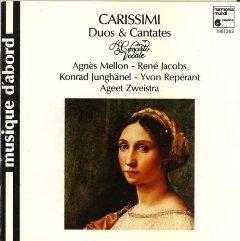Carissimi – Duos & Cantates (1987)
Carissimi – Duos & Cantates (1987)

1. Il mio core è un mar di pianti (duetto) (5:06) 2. Bel tempo per me se n'andò (contre-ténor) (5:57) 3. Tu m'hai preso (soprano) (5:29) 4. Lettera amorosa (contre-ténor) (8:56) 5. I filosofo (duetto) (8:45) 6. Partenza dalla sua Donna (duetto) (2:20) 7. Lungi omai, deh, spiega i vanni (duetto) (2:19) 8. Così volete (soprano) (7:03) 9. Sonetto: Hor che di Sirio (contre-ténor) (7:43) 10. Deh, memoria (soprano) (6:01) 11. Peregrin d'ignoto sponde (duetto) (4:38) 12. Vaghi rai, pupille ardenti (duetto) (3:46) Concerto Vocale: Agnes Mellon, soprano Rene Jacobs, contre-tenor Ageet Zweistra, violoncelle Yvon Reperant, clavecin Konrad Junghanel, theorbe Rene Jacobs, director.
Perhaps worthy of being designated the father of the oratorio, Giacomo Carissimi was among the most important Italian composers of the seventeenth century. He is best remembered for his oratorios and cantatas. Carissimi was born somewhere near Rome and baptized on April 18, 1605; an exact date of birth is not known. He was the son of an artisan, but he must have received a good deal of early musical training, for at the age of 18 he was recorded as a member of the Tivoli Cathedral choir. In 1625, he became the organist at the cathedral, and soon after that began composing.
Carissimi received his first and only important appointment in 1629: he became maestro di cappella of the Collegio Germanico in Rome. The Collegio Germanico was, at that time, a major center for Jesuit learning; Carissimi's position there commanded considerable influence and respect, and the composer would remain there until his death. As maestro di cappella, Carissimi was responsible for the musical training of students, the directorship of the choir, and the preparation of music for services at the church of St. Apollinare. In 1637, he was ordained as a priest. Carissimi became well-known and well-respected in Italy and across Europe, and was invited to accept employment at a number of important churches and courts. He turned down the opportunity to succeed Monteverdi at the famous St. Mark's in Venice, however, and likewise declined to serve in the court of the governor of the Netherlands.
While it is difficult to accurately catalog and date Carissimi's music, it is certain that he was one of the originators of the oratorio genre. His oratorios are notable for their clear text settings, the importance given to the chorus, and the use of expressive gestures to intensify and illustrate meanings in the text. The influence of early opera, and of Monteverdi in particular, is evident in the oratorios, and Carissimi's free alternation of aria- and recitative-style passages is considered an important contribution to the development and refinement of operatic recitative. All the operatic means, however, are turned to religious ends; Carissimi's oratorios are sacred pieces, not the middle-class entertainments that Handel would create a century later. Carissimi also met with fame as a composer of cantatas, and, as with the oratorio, he advanced that genre substantially.
Carissimi was an influential figure, and several composers of the next generation bear the marks of his innovations and style. These included Alessandro Scarlatti in Italy, Christoph Bernhard in Germany, and Marc-Antoine Charpentier in France. --- Alexander Carpenter, Rovi
download: uploaded anonfiles yandex 4shared solidfiles zalivalka mega filecloudio mediafire








